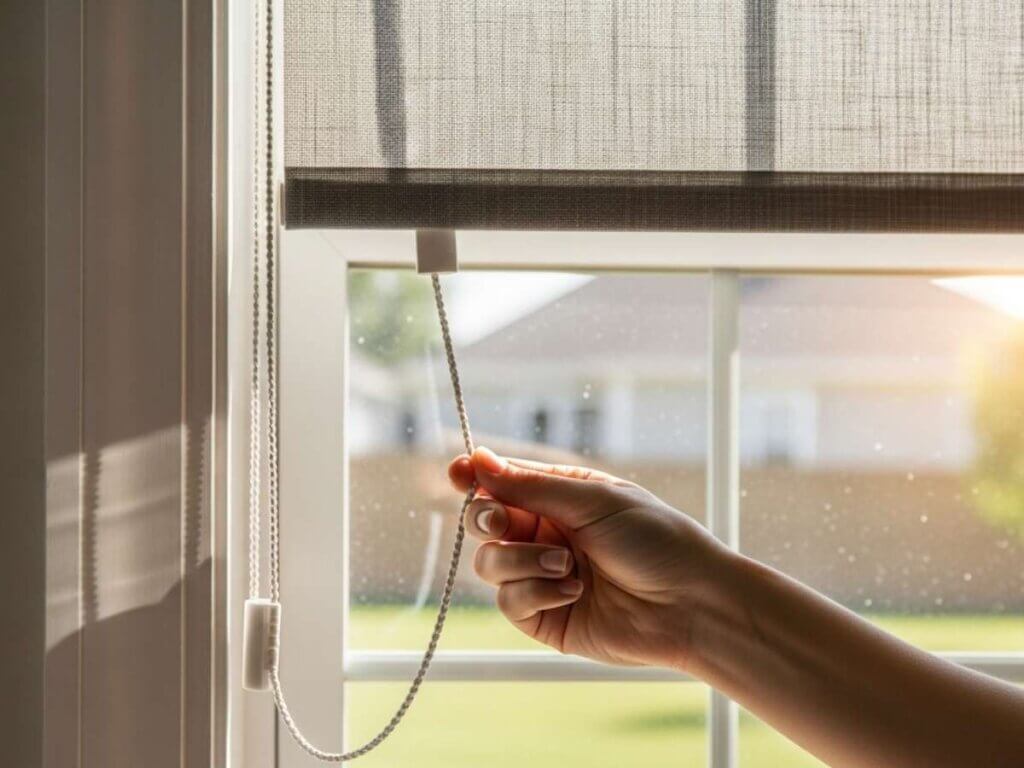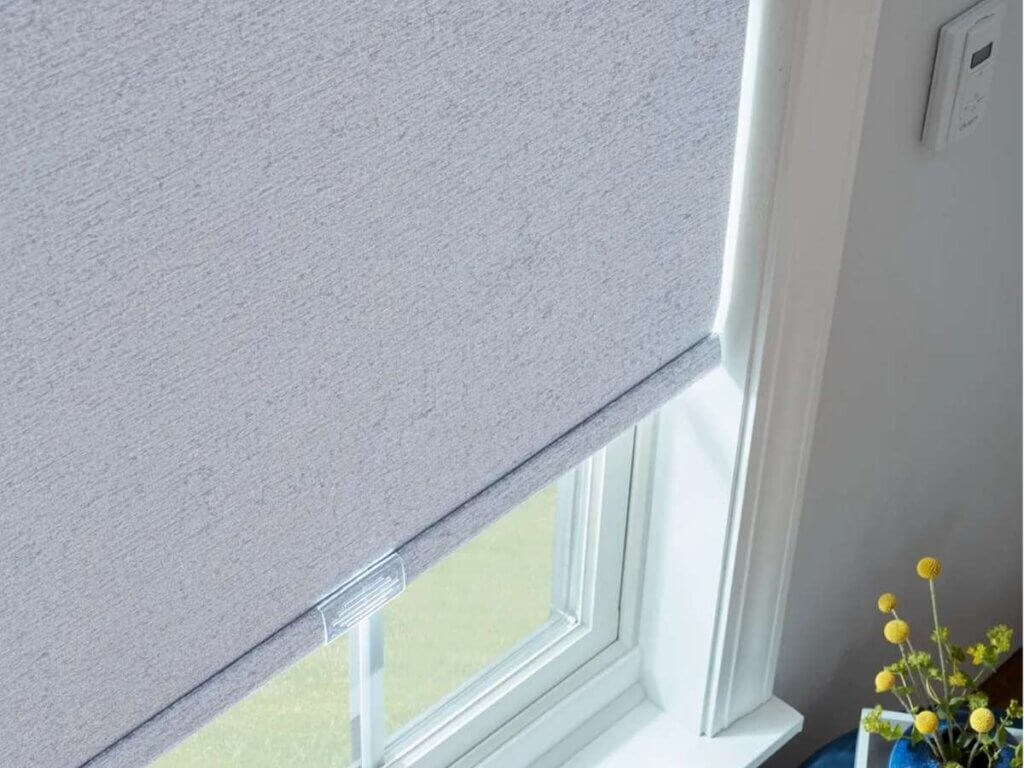Each year, Window Covering Safety Month highlights an often-overlooked household risk—window cords. While window coverings add beauty and privacy, older designs with exposed or dangling cords can pose serious strangulation hazards for young children and pets. This moment of awareness encourages homeowners to reevaluate their spaces and make small yet significant updates that enhance home safety and security.
In this blog, we’ll walk you through five key steps to include in your home safety checklist, from identifying unsafe window treatments to upgrading to cordless blinds or motorized shades. You’ll also learn how smart furniture placement, retrofit kits, and awareness of emergency exits can reduce risks around your windows.
1. Inspect and Eliminate Exposed or Dangling Cords

Start your checklist with a thorough inspection of all your window coverings. Check for exposed cords, dangling cords, or inner cords that are within reach of children. Even cords you think are out of the way can quickly become a hazard when furniture is moved or kids start to climb.
If you find any older blinds or shades with accessible cords, it’s time to replace or modify them. Many modern cordless blinds, roller shades, and vertical blinds are designed with Best for Kids™ certification, meaning they meet the industry’s highest child safety standards.
For homes that aren’t ready for full replacement, cord cleats or retrofit kits can help keep cords securely out of reach until you’re ready to upgrade.
2. Upgrade to Cordless or Motorized Window Treatments

One of the best ways to eliminate the risk of strangulation is to replace old window coverings with cordless or motorized blinds. These modern options not only enhance safety but also add a sleek, clutter-free look to your home.
Cordless window shades are simple to operate with a gentle push or pull, while motorized blinds allow for complete control through a remote, wall switch, or smart home system. For families with young children or pets, this upgrade eliminates cords entirely—ensuring a cord-free system that keeps your windows functional and safe.
3. Reevaluate Furniture Placement Around Windows
Children are naturally curious and love to climb. This October, take a few minutes to examine how your furniture is arranged. Cribs, beds, couches, and chairs placed near windows can give kids easy access to blind cords or window shades.
To minimize this risk, move furniture away from windows whenever possible. Creating a clear space not only keeps cords out of reach but also helps maintain a safe emergency exit path in case of a fire or other emergency.
4. Install Cord Cleats and Safety Devices
If you still use window treatments with cords, installing cord cleats is a quick and effective safety measure. These simple devices allow you to wrap cords tightly and keep them high and out of reach. Mount them at least 64 inches above the floor for maximum protection.
For added peace of mind, consider quick-release devices that allow cords to detach under pressure—preventing potential entanglement. Many safety organizations, including the CPSC, recommend using both cleats and tension devices on older horizontal blinds and roller shades to meet modern safety expectations.
5. Review Your Home’s Emergency and Safety Plan
A well-rounded home safety checklist should go beyond window cords. Take the opportunity to revisit your family’s fire escape plan, test smoke detectors, and inspect window guards.
Ensure that every family member knows how to open windows quickly in case of an emergency, especially if safety devices or window coverings are installed. While childproofing is essential, windows must remain functional as emergency exits. Balancing window treatment safety with accessibility can literally save lives.
Bonus Tip: Know When to Replace Your Window Coverings
Window treatments don’t last forever—especially older blinds with inner cords or outdated safety features. If your coverings are more than a decade old, they may not meet current safety standards. Replacing them with modern cordless blinds or smart home-compatible shades ensures both safety and style, while providing access to energy-efficient and easy-to-operate designs.
Safe Choices to Make—and Mistakes to Avoid
Smart Safety Moves
- Replace old blinds with cordless or motorized versions.
- Use cord cleats or tension devices to secure loose cords.
- Keep furniture and cribs at least three (3) feet away from windows.
- Regularly inspect cords and hardware for signs of wear or damage.
Avoid These Safety Oversights
- Don’t tie cords together—they can form dangerous loops.
- Don’t assume short cords are safe; secure them properly.
- Don’t block window exits with heavy furniture.
- Don’t overlook less-used rooms—every window counts.
Frequently Asked Questions (FAQs)
1. Why is Window Covering Safety Month important?
This event is a national campaign focused on raising awareness about the strangulation risks associated with window cords. It encourages homeowners to inspect, replace, or retrofit their window coverings to ensure safer environments for children and pets. The campaign also educates the public about safer alternatives such as cordless blinds and motorized shades.
2. What are the safest types of window coverings for homes with children?
The safest options include cordless blinds, roller shades, and motorized window treatments. These designs remove or conceal cords entirely, making them child-safe and compliant with Best for Kids™ certification standards. Choosing these treatments greatly reduces the risk of entanglement or strangulation.
3. Can I retrofit my existing blinds to make them safer?
Yes, many older blinds can be upgraded using retrofit kits approved by the CPSC. These kits typically include cord cleats, tension devices, or quick-release mechanisms that help reduce hazards. However, the safest long-term solution is replacing older corded blinds with modern cordless or motorized options.
Create a Safer and More Family-Friendly Environment
Window Covering Safety Month serves as a crucial reminder that small updates can make a significant difference. Whether it’s securing a dangling cord, adjusting your furniture layout, or investing in cordless or motorized blinds, each step contributes to a safer and more comfortable home.
Ready to assess your home’s window treatment safety?
Book a free consultation with Made in the Shade Eastern Shore today. Our team proudly serves homeowners across Maryland and Delaware beaches, helping families create stylish, child-safe spaces with high-quality window coverings that meet today’s safety standards.
Protect what matters most—start your safety checklist this month and give your family the peace of mind they deserve.


